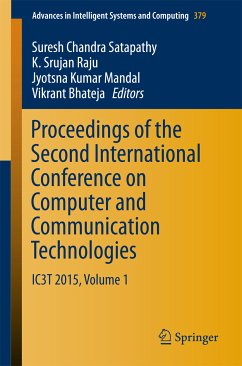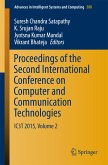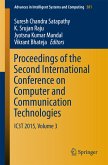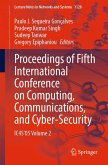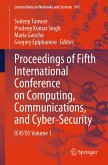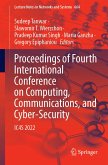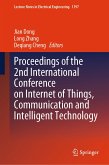Proceedings of the Second International Conference on Computer and Communication Technologies (eBook, PDF)
IC3T 2015, Volume 1
Redaktion: Satapathy, Suresh Chandra; Bhateja, Vikrant; Mandal, Jyotsna Kumar; Raju, K. Srujan


Alle Infos zum eBook verschenken

Proceedings of the Second International Conference on Computer and Communication Technologies (eBook, PDF)
IC3T 2015, Volume 1
Redaktion: Satapathy, Suresh Chandra; Bhateja, Vikrant; Mandal, Jyotsna Kumar; Raju, K. Srujan
- Format: PDF
- Merkliste
- Auf die Merkliste
- Bewerten Bewerten
- Teilen
- Produkt teilen
- Produkterinnerung
- Produkterinnerung

Hier können Sie sich einloggen

Bitte loggen Sie sich zunächst in Ihr Kundenkonto ein oder registrieren Sie sich bei bücher.de, um das eBook-Abo tolino select nutzen zu können.
The book is about all aspects of computing, communication, general sciences and educational research covered at the Second International Conference on Computer & Communication Technologies held during 24-26 July 2015 at Hyderabad. It hosted by CMR Technical Campus in association with Division - V (Education & Research) CSI, India. After a rigorous review only quality papers are selected and included in this book. The entire book is divided into three volumes. Three volumes cover a variety of topics which include medical imaging, networks, data mining, intelligent computing, software design,…mehr
- Geräte: PC
- ohne Kopierschutz
- eBook Hilfe
- Größe: 25.04MB
![Proceedings of the Second International Conference on Computer and Communication Technologies (eBook, PDF) Proceedings of the Second International Conference on Computer and Communication Technologies (eBook, PDF)]() Proceedings of the Second International Conference on Computer and Communication Technologies (eBook, PDF)161,95 €
Proceedings of the Second International Conference on Computer and Communication Technologies (eBook, PDF)161,95 €![Proceedings of the Second International Conference on Computer and Communication Technologies (eBook, PDF) Proceedings of the Second International Conference on Computer and Communication Technologies (eBook, PDF)]() Proceedings of the Second International Conference on Computer and Communication Technologies (eBook, PDF)161,95 €
Proceedings of the Second International Conference on Computer and Communication Technologies (eBook, PDF)161,95 €![Proceedings of Third International Conference on Computing, Communications, and Cyber-Security (eBook, PDF) Proceedings of Third International Conference on Computing, Communications, and Cyber-Security (eBook, PDF)]() Proceedings of Third International Conference on Computing, Communications, and Cyber-Security (eBook, PDF)169,95 €
Proceedings of Third International Conference on Computing, Communications, and Cyber-Security (eBook, PDF)169,95 €![Proceedings of Fifth International Conference on Computing, Communications, and Cyber-Security (eBook, PDF) Proceedings of Fifth International Conference on Computing, Communications, and Cyber-Security (eBook, PDF)]() Proceedings of Fifth International Conference on Computing, Communications, and Cyber-Security (eBook, PDF)202,95 €
Proceedings of Fifth International Conference on Computing, Communications, and Cyber-Security (eBook, PDF)202,95 €![Proceedings of Fifth International Conference on Computing, Communications, and Cyber-Security (eBook, PDF) Proceedings of Fifth International Conference on Computing, Communications, and Cyber-Security (eBook, PDF)]() Proceedings of Fifth International Conference on Computing, Communications, and Cyber-Security (eBook, PDF)202,95 €
Proceedings of Fifth International Conference on Computing, Communications, and Cyber-Security (eBook, PDF)202,95 €![Proceedings of Fourth International Conference on Computing, Communications, and Cyber-Security (eBook, PDF) Proceedings of Fourth International Conference on Computing, Communications, and Cyber-Security (eBook, PDF)]() Proceedings of Fourth International Conference on Computing, Communications, and Cyber-Security (eBook, PDF)193,95 €
Proceedings of Fourth International Conference on Computing, Communications, and Cyber-Security (eBook, PDF)193,95 €![Proceedings of the 2nd International Conference on Internet of Things, Communication and Intelligent Technology (eBook, PDF) Proceedings of the 2nd International Conference on Internet of Things, Communication and Intelligent Technology (eBook, PDF)]() Proceedings of the 2nd International Conference on Internet of Things, Communication and Intelligent Technology (eBook, PDF)258,95 €
Proceedings of the 2nd International Conference on Internet of Things, Communication and Intelligent Technology (eBook, PDF)258,95 €-
-
-
Dieser Download kann aus rechtlichen Gründen nur mit Rechnungsadresse in A, B, BG, CY, CZ, D, DK, EW, E, FIN, F, GR, HR, H, IRL, I, LT, L, LR, M, NL, PL, P, R, S, SLO, SK ausgeliefert werden.
- Produktdetails
- Verlag: Springer India
- Seitenzahl: 807
- Erscheinungstermin: 4. September 2015
- Englisch
- ISBN-13: 9788132225171
- Artikelnr.: 43784060
- Verlag: Springer India
- Seitenzahl: 807
- Erscheinungstermin: 4. September 2015
- Englisch
- ISBN-13: 9788132225171
- Artikelnr.: 43784060
- Herstellerkennzeichnung Die Herstellerinformationen sind derzeit nicht verfügbar.
Surveillance Videos.- Chapter 22. Protecting the Augmented Browser Extension from Mutation Cross-site Scripting.- Chapter 23. Large Scale Data Management System Using Data De-duplication System.- Chapter 24. Movement detection Using LabVIEW by Analysis of Real Time Video.- Chapter 25. Connectivity Model for Molecular Communication Based Nano Machines Network in Normal and Sub-diffusive Regimes.- Chapter 26. Application of Locally Weighted Regression for Predicting Faults Using Software Entropy Metrics.- Chapter 27. Effect of Defects on Current-Voltage Characteristics of a Silicene ZNR Based Field Effect Transistor.- Chapter 28. Performance Improvement of Read Operations in Distributed File System through Anticipated Parallel Processing.- Chapter 29. Steerable Texture Descriptor for an Effective Content Based Medical Image Retrieval System Using PCA.- Chapter 30. A Novel Multi-View Similarity for Clustering Spatio-Temporal Data.- Chapter 31. WRSP-Miner Algorithm for Mining Weighted Sequential Patterns from Spatio-Temporal Databases.- Chapter 32. Performance Analysis in Free Space Optical Communication System Using Aperture Averaging.- Chapter 33. Performance Evaluation of Free Space Optical Link Under Various Weather Conditions.- Chapter 34. Evolutionary Improved Swarm Based Hybrid K-means Algorithm for Cluster Analysis.- Chapter 35. Analysis of Energy Efficient, LEACH Based Cooperative Wireless Sensor Network.- Chapter 36. A Monotonic Digitally Controlled Delay Element Based Programmable Trigger Pulse Generator.- Chapter 37. Layered-Encoding Video Multicasting IPTV over Mobile WiMAX Networks.- Chapter 38. Intuitionistic Fuzzy Similarity and Information Measures with Physical Education Teaching Quality Assessment.- Chapter 39. Molecular Level Insight into the Interactions of SoxC and SoxD from Epsilonproteobacteria Sulfurimonas Denitrificans: A Bio-Molecular Computational Approach.- Chapter 40. "Jugaad" - the Creativeness for Selection of Software Development Methodology Advisory System - Fuzzy Expert System.- Chapter 41. A Framework for Data Clustering of Large Datasets in a Distributed Environment.- Chapter 42. Segmentation of Ancient and Historical Gilgit Manuscripts.- Chapter 43. Semantic-Based Approach for Automatic Annotation and Classification of Medical Services in Healthcare Ecosystem.- Chapter 44. Real Time Graphs For Communication Networks: A Fuzzy Mathematical Model.- Chapter 45. PWLCM Based Random Search for Strong Substitution Box Design.- Chapter 46. Fuzzy C-means and Fuzzy TLBO for Fuzzy Clustering.- Chapter 47. A Mean Based Thresholding Approach for Broken Character Segmentation from Printed Gujarati Documents.- Chapter 48. Entity Resolution Based Jaccard Similarity Coefficient for Heterogeneous Distributed Databases.- Chapter 49. Energy Efficient Algorithms for Hot Spot Problem in Wireless Sensor Networks.- Chapter 50. Mining Community Based Top-k Experts and Learners in Online Question Answering Systems.- Chapter 51. An Approach for Creating framework for Automated Question Generation from Instructional Objective.- Chapter 52. Adaptive Output Feedback Control System Design for Low Cost Electronic Knee Prosthesis.- Chapter 53. Low Leakage Low Power High Stable SRAM Cell Design.- Chapter 54. Optimizing Routes in Mobile Ad hoc Networks Using Genetic Algorithm and Ant Colony Optimization.- Chapter 55. Concatenation Technique for Extracted Arabic Characters for Efficient Content Based Indexing and Searching.- Chapter 56. Harmonic elimination Using DSTATCOM.- Chapter 57. Fault Tolerance in Wireless Sensor Networks: Finding Primary Path.- Chapter 58. PSO Based Multiple-Sink Placement Algorithm for Pro-tracting the Lifetime of Wireless Sensor Networks.- Chapter 59. De-noising of GPS Positioning Data Using Wavelet Based Hidden Markov Tree.- Chapter 60. Parent Selection Based on Link Quality Estimation in WSN.- Chapter 61. Enhanced Higher Order Orthogonal Iteration Algorithm for Student Performance Prediction.- Chapter 62. A One to One Communication Model to Facilitate Conversation between Differently-abled People by a Portable and Handy Machine.- Chapter 63. Malicious File Hash Detection and Drive-by Download Attacks.- Chapter 64. Parameter Optimization of Support Vector Machine by Improved Ant Colony Optimization.- Chapter 65. KT3F: A Key Based Two Tier Trust Management Filtering Scheme for Intrusion Detection in Wireless Sensor Network.- Chapter 66. Cascading De-noising Algorithm for Improving GPS Positional Accuracy.- Chapter 67. A Corpus of Word-level Offline Handwritten Numeral Images from Official Indic Scripts.- Chapter 68. A Planar Ultra-Wide Band Antenna Design Using Circularly Truncated Corners and Notches.- Chapter 69. Genetic Algorithm for k-connected Relay Node Placement in Wireless Sensor Networks.- Chapter 70. Segmentation of Cotton Bolls by Efficient Feature Selection Using Conventional Fuzzy C Means Algorithm with Perception of Color.- Chapter 71. System Dynamics Modeling for Analyzing Recovery Rate of Diabetic Patients by Mapping Sugar Content in Ice Cream and Sugar Intake for the Day.- Chapter 72. Enhanced Stable Period for Two Level and Multilevel Heterogeneous Model for Distant Base Station in Wireless Sensor Network.- Chapter 73. Dynamic Timetable Generation Using Constraint Satisfaction Algorithm.- Chapter 74. Application of Genetic Algorithm for Evolution of Quantum Fourier Transform Circuits.- Chapter 75. An Improved Polygon Clipping Algorithm Based on Affine Transformation.- Chapter 76. Alternative Design Space Analysis for Electronic Commerce System.
Surveillance Videos.- Chapter 22. Protecting the Augmented Browser Extension from Mutation Cross-site Scripting.- Chapter 23. Large Scale Data Management System Using Data De-duplication System.- Chapter 24. Movement detection Using LabVIEW by Analysis of Real Time Video.- Chapter 25. Connectivity Model for Molecular Communication Based Nano Machines Network in Normal and Sub-diffusive Regimes.- Chapter 26. Application of Locally Weighted Regression for Predicting Faults Using Software Entropy Metrics.- Chapter 27. Effect of Defects on Current-Voltage Characteristics of a Silicene ZNR Based Field Effect Transistor.- Chapter 28. Performance Improvement of Read Operations in Distributed File System through Anticipated Parallel Processing.- Chapter 29. Steerable Texture Descriptor for an Effective Content Based Medical Image Retrieval System Using PCA.- Chapter 30. A Novel Multi-View Similarity for Clustering Spatio-Temporal Data.- Chapter 31. WRSP-Miner Algorithm for Mining Weighted Sequential Patterns from Spatio-Temporal Databases.- Chapter 32. Performance Analysis in Free Space Optical Communication System Using Aperture Averaging.- Chapter 33. Performance Evaluation of Free Space Optical Link Under Various Weather Conditions.- Chapter 34. Evolutionary Improved Swarm Based Hybrid K-means Algorithm for Cluster Analysis.- Chapter 35. Analysis of Energy Efficient, LEACH Based Cooperative Wireless Sensor Network.- Chapter 36. A Monotonic Digitally Controlled Delay Element Based Programmable Trigger Pulse Generator.- Chapter 37. Layered-Encoding Video Multicasting IPTV over Mobile WiMAX Networks.- Chapter 38. Intuitionistic Fuzzy Similarity and Information Measures with Physical Education Teaching Quality Assessment.- Chapter 39. Molecular Level Insight into the Interactions of SoxC and SoxD from Epsilonproteobacteria Sulfurimonas Denitrificans: A Bio-Molecular Computational Approach.- Chapter 40. "Jugaad" - the Creativeness for Selection of Software Development Methodology Advisory System - Fuzzy Expert System.- Chapter 41. A Framework for Data Clustering of Large Datasets in a Distributed Environment.- Chapter 42. Segmentation of Ancient and Historical Gilgit Manuscripts.- Chapter 43. Semantic-Based Approach for Automatic Annotation and Classification of Medical Services in Healthcare Ecosystem.- Chapter 44. Real Time Graphs For Communication Networks: A Fuzzy Mathematical Model.- Chapter 45. PWLCM Based Random Search for Strong Substitution Box Design.- Chapter 46. Fuzzy C-means and Fuzzy TLBO for Fuzzy Clustering.- Chapter 47. A Mean Based Thresholding Approach for Broken Character Segmentation from Printed Gujarati Documents.- Chapter 48. Entity Resolution Based Jaccard Similarity Coefficient for Heterogeneous Distributed Databases.- Chapter 49. Energy Efficient Algorithms for Hot Spot Problem in Wireless Sensor Networks.- Chapter 50. Mining Community Based Top-k Experts and Learners in Online Question Answering Systems.- Chapter 51. An Approach for Creating framework for Automated Question Generation from Instructional Objective.- Chapter 52. Adaptive Output Feedback Control System Design for Low Cost Electronic Knee Prosthesis.- Chapter 53. Low Leakage Low Power High Stable SRAM Cell Design.- Chapter 54. Optimizing Routes in Mobile Ad hoc Networks Using Genetic Algorithm and Ant Colony Optimization.- Chapter 55. Concatenation Technique for Extracted Arabic Characters for Efficient Content Based Indexing and Searching.- Chapter 56. Harmonic elimination Using DSTATCOM.- Chapter 57. Fault Tolerance in Wireless Sensor Networks: Finding Primary Path.- Chapter 58. PSO Based Multiple-Sink Placement Algorithm for Pro-tracting the Lifetime of Wireless Sensor Networks.- Chapter 59. De-noising of GPS Positioning Data Using Wavelet Based Hidden Markov Tree.- Chapter 60. Parent Selection Based on Link Quality Estimation in WSN.- Chapter 61. Enhanced Higher Order Orthogonal Iteration Algorithm for Student Performance Prediction.- Chapter 62. A One to One Communication Model to Facilitate Conversation between Differently-abled People by a Portable and Handy Machine.- Chapter 63. Malicious File Hash Detection and Drive-by Download Attacks.- Chapter 64. Parameter Optimization of Support Vector Machine by Improved Ant Colony Optimization.- Chapter 65. KT3F: A Key Based Two Tier Trust Management Filtering Scheme for Intrusion Detection in Wireless Sensor Network.- Chapter 66. Cascading De-noising Algorithm for Improving GPS Positional Accuracy.- Chapter 67. A Corpus of Word-level Offline Handwritten Numeral Images from Official Indic Scripts.- Chapter 68. A Planar Ultra-Wide Band Antenna Design Using Circularly Truncated Corners and Notches.- Chapter 69. Genetic Algorithm for k-connected Relay Node Placement in Wireless Sensor Networks.- Chapter 70. Segmentation of Cotton Bolls by Efficient Feature Selection Using Conventional Fuzzy C Means Algorithm with Perception of Color.- Chapter 71. System Dynamics Modeling for Analyzing Recovery Rate of Diabetic Patients by Mapping Sugar Content in Ice Cream and Sugar Intake for the Day.- Chapter 72. Enhanced Stable Period for Two Level and Multilevel Heterogeneous Model for Distant Base Station in Wireless Sensor Network.- Chapter 73. Dynamic Timetable Generation Using Constraint Satisfaction Algorithm.- Chapter 74. Application of Genetic Algorithm for Evolution of Quantum Fourier Transform Circuits.- Chapter 75. An Improved Polygon Clipping Algorithm Based on Affine Transformation.- Chapter 76. Alternative Design Space Analysis for Electronic Commerce System.
